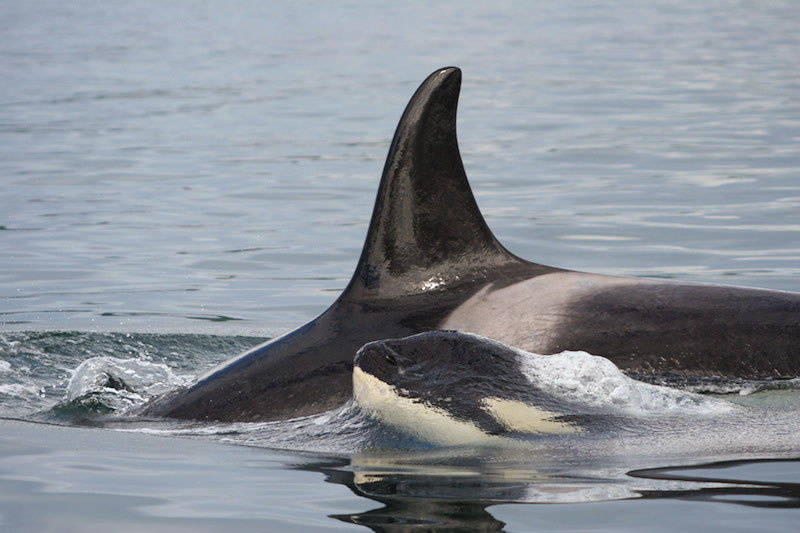Submitted by NOAA Fisheries
With news of multiple pregnancies among the endangered Southern Resident killer whales, agencies and partners are calling for boaters to steer clear of the whales. The Washington Department of Fish and Wildlife, NOAA Fisheries, whale watch leaders, and Soundwatch are asking boaters to give the whales extra space on the water at this critical time.
”The whales, for the first time in a couple years, are very, very present in Puget Sound; and unfortunately we’re having a lot of people get too close to orcas within these regulated boundaries,” said Washington Department of Fish and Wildlife Police Captain Alan Myers. “That bubble of protection is extremely important in order to keep boaters either intentionally or unintentionally from interfering with these animals while they feed, forage, and move about in Washington’s waters.”
A photogrammetry team from SR3 and Southall Environmental Associates last month documented pregnancies in all three Southern Resident pods. While this is promising news, research has shown that many Southern Resident pregnancies fail or the calves do not survive beyond their first year.
The lack of sufficient Chinook salmon prey is a key issue for the whale population. Another concern is the sound from vessel traffic, which can interrupt echolocation clicks the whales use to hunt the salmon. In the presence of vessel traffic, the whales have been observed by researchers spending less time foraging and more time traveling. Research has also found that the speed of vessels, more so than their size, is the biggest factor in determining how much noise they produce. Slowing down is one of the best ways to allow pregnant females to find the prey they need.
New regulations protect Southern residents
Washington Gov. Jay Inslee signed new killer whale viewing regulations into law last year. They require vessels to stay at least 300 yards from Southern Resident killer whales and at least 400 yards out of their path or behind the whales. Vessels must also reduce their speed to seven knots within a half-mile of a Southern Resident killer whale.
The Pacific Whale Watch Association has also developed science-based guidelines to give the whales space and minimize impacts. For example, they adopted a speed limit before it was required, given the relationship to noise, said Kelley Balcomb-Bartok, Communications Director for the Association.
“If you’re out in your boat and you see a whale watch vessel traveling slowly, or giving certain whales extra space, please slow down or go around,” Balcomb-Bartok says. “Our naturalists can tell whales apart, they can often tell you the whale’s life history, their family trees, and provide a brief peek into the mysterious lives of whales.”
Boaters are encouraged to watch for the Whale Warning Flag. This is an optional tool from the San Juan County Marine Resources Committee that lets others know that there might be whales nearby. If you see the flag, slow down and keep a sharp lookout for whales.
“Transient killer whales are also found in Washington waters, so if boaters cannot identify which killer whales they are seeing, they should be cautious and follow the rules for the Southern Residents,” said Lynne Barre, Branch Chief for Protected Resources in NOAA Fisheries West Coast Region.
Help with protecting the orcas
For the latest details on regulations and guidelines, visit BeWhaleWise.org, which includes illustrations explaining the latest changes. Boaters can download a brochure before heading out on the water or keep an eye out for the Soundwatch Boater Education Program.
“An important part of our mission is to educate the boaters of the Salish Sea on the updated regulations for Southern Resident Killer Whales,” said Alanna Frayne, Soundwatch Program Coordinator at The Whale Museum in Friday Harbor. “This is crucial not only to their health but also their recovery, as the pregnant whales will be especially vulnerable to disturbances.”
More than 400 people responded in October to a request by NOAA Fisheries for comments on vessel regulations. NOAA Fisheries is now considering that input, new information available, and the effectiveness of existing regulations to determine whether and how the agency might update federal regulations. The agency gained additional insight from the Governor’s Orca Task Force and its recommendations regarding vessels. NOAA Fisheries is also a partner on The Whale Trail, a series of land-based sites to view whales from shore.
“Consider it tiptoeing so you don’t disturb them.”
“By staying alert, going slow, and giving these whales extra space during this critical time, boaters can quiet the waters so the pregnant whales can find food,” said Julie Watson, Washington Department of Fish and Wildlife killer whale policy lead. “Consider it tiptoeing so you don’t disturb them.”




